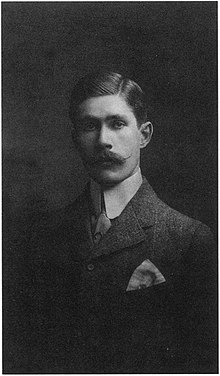Albert Eugene Gallatin
| Albert Eugene Gallatin | |
|---|---|

Portrait, 1905
|
|
| Born |
July 23, 1881 Villanova, Pennsylvania |
| Died | June 15, 1952 (aged 70) |
| Nationality | American |
Albert Eugene Gallatin wrote about, collected, exhibited, and created works of art. Called "one of the great figures in early 20th-century American culture," he was a leading proponent of nonobjective and later abstract and particularly Cubist art whose "visionary approach" in both collecting and painting left "an enduring impact on the world of modern art."
Gallatin was born in 1881 into a wealthy and socially prominent family. Showing a youthful interest in art and literature, he began to collect works by Max Beerbohm, Aubrey Beardsley, and James McNeill Whistler while still in his teens. The common element in these purchases was a preference for works that he saw as possessing a harmonious, refined, and decorative nature, rather than a naturalistic or literal one. He appreciated their aesthetic over their narrative content and their intrinsic over their didactic or utilitarian value.
As he collected art, he also began to write about it. For the two decades following the turn of the century, Gallatin produced a constant stream of articles, small monographs, and books of engraved plates. Between 1900 and 1910 most of these concerned Beardsley and Whistler. In examining their drawings and paintings he sought to find out what gave these works enduring value as opposed to superficial and temporary popularity. To him, their excellence showed in elegance of line and quality of design. He also drew attention to what he called a "decorative feeling" in works by these two artists in contrast to what he considered to be the less aesthetic realism of Degas and Millet. He maintained that modern art did not become popular because it was good, but because it scandalized. For example, in 1902 he wrote that Beardsley's drawings attracted notice by their shocking distortion of perspective and proportion and their escape from artistic conventions. Because their true value was not readily apparent, he believed that only connoisseurs along with Beardsley's fellow artists could fully appreciate them. In another article, he called Whistler an artist "whose work must remain more or less incomprehensible to the general public." He also wrote that the best art was created solely for its own sake. He wrote of Whistler's "unflinching devotion to beauty" and freedom from "commercialism, vulgarity, and the spirit of gain." Gallatin said Whistler's subjects were never ugly or lacking taste. In his view, Whistler was not a realist because he never descended to the obvious or commonplace.
When his father died in 1902, Gallatin became head of a family consisting of himself, two sisters, and their mother. As a member of New York's social elite he gave and attended high-profile dinners, dances, weddings, and benefits. His name appeared frequently in the press as a result these activities and also as a result of his pioneering affection for automobiles and motor sport. His inheritance made it unnecessary for him to work for a living and he chose not to follow the lead of other members of his class by engaging in banking, stock brokerage, or other professional occupation. Instead, he continued to collect art and to enhance his reputation as an art connoisseur by his writings.
...
Wikipedia
